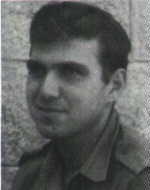Son of Aharon-David and Chana. He was born on March 21, 1949 in Tel Aviv. He attended the Ayalon School in Nahalat Yitzhak and the ORT vocational high school in Givatayim. From his youth he was a member of the Scouts movement in Givatayim, also called “Scouts of Fire,” being adopted by the fire brigade in Givatayim. The movement was prominent in everything, including sports, especially soccer and basketball, and also in the cultural sphere. No action was taken without him and he did not miss a trip or a journey in the movement. He was a gifted student, a son very devoted to his parents and a very loyal friend of his friends. On trips, trips, and labor camps of the youth movement he participated, and on his firm young shoulders he would load the bags of stragglers on the way. He was always willing to help in times of danger and fire, and he saw it: he took part in putting out the burning of a factory in Be’er Sheva, took him out and passed him to the local hospital. Wolf fled his bed and dodged the hospital, and soon he was seen again in the smoking yard of the factory, continuing his stubborn war. He was a member of the “Scouts” movement from the fourth grade until he left for Nahal, he joined the movement in the Giv’atayim tribe, grew up with the battalion and helped to give him a new character in the framework of “Shilat Gonen.” He took part in a training course and was given a training certificate. He was also a member of the dance and dance group of the Givatayim Municipality, and was joined by the IDF in September 1967 and was one of the Magshimim who went to the Nahal as a member of the “Tzur” nucleus. In his mind he saw himself dressed in sweaty sweatshirts, and even khaki clothes as long as it was khaki of peace, of tractors and combs Half wars. Bsl”t Rosh Hanikra did earlier worked in the orchard, and then came out with basic training and core training in Neve Eitan Beit She’an Valley. There, in addition to his agricultural work, he took part in the IDF’s military operations, and then came a series of events: a summer of ambushes and endless patrols in the burning valley and winter, at the level, between the barracks of the Golan Nahal outpost. When he was at Rosh Hanikra, he had a girlfriend and was about to marry her. He met in the Beit Shean Valley and was a student at the Gymnasium, where he served in the IDF, and in the Nahal Brigade, the boys spent days and nights in long guard duty and when he completed his service in the Nahal Brigade, Ze’ev participated in the advanced training course in Habla, The rank of corporal. Ze’ev’s wedding day was set for mid-August. But that day his unit was supposed to be around the canal. Zeev managed to get out of the line a few weeks before August 18, 1970, when his Suez days would be behind him, and then, after the wedding, he could return to the farm. On April 28, 1970, Ze’ev was killed by an enemy bombardment near the Suez Canal. He was laid to rest in the military cemetery in Kiryat Shaul. The commander of Nahal-Golan wrote a few lines in Ze’ev’s memory: “As Ze’ev’s former commander during a period of his army service, I did not know him very closely. I remember several meetings because of the job. His strongest moment was stubbornness. It was not a ‘stubbornness of a mule’ but a stubbornness about things that he thought were unjust. There were cases where someone was wronged (and not necessarily to a wolf) and then came to his aid. He would fight almost to the end – the daily contact between a soldier and his commander does not always allow for deep personal acquaintance, and therefore there was no such thing. Ze’ev was a sociable guy, loyal to his job and his friends. Due to a low medical profile, he could not reach the soul of any Nachalai.We all have no control over her). It seems that this is the price that we must pay daily, so that the civilian residences of the Jewish people can live in peace, peace and tranquility. “In May 1970, an article was published about Ze’ev in the journal of the Hebrew Scouts Union in Israel; After the fall, a pamphlet called “Ze’ev” was published by his family.
